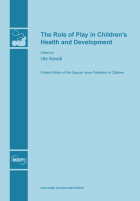The Role of Play in Children’s Health and Development
A special issue of Children (ISSN 2227-9067).
Deadline for manuscript submissions: closed (30 June 2014) | Viewed by 98740
Special Issue Editor
Interests: children’s rights; disabled children; children’s play; gender; internet safety; community empowerment; playing in nature
Special Issue Information
Dear Colleagues,
The importance and benefits of play for the holistic development of children are not always appreciated by professionals working in fields such as child welfare, health, education, and housing. Whilst earlier generations of children often played freely outdoors, today’s children around the globe face many barriers to play, not least because of the ‘toxic’ environments humankind has created. Yet play “heralds the beginning of civilisation by imposing routines, rituals, and rules upon the expression of the universal primary and relentless adaptive emotions (loneliness, anger, fear, shock, disgust, and apathy)” (Brian Sutton-Smith). Play research has progressed our knowledge but has yet to reach wider audiences and influence practice. Many aspects of and assumptions surrounding play—and even definitions—remain controversial and subject to debate.
Play benefits all children, and has protective and preventative functions. With a focus on health, this special issue addresses: the benefits of play for children’s physical and mental health; play at different developmental stages; and the therapeutic power of play. “Opportunities for play can help children to work through difficult experiences, to make sense of life around them, to cope better with changes that have happened in their lives and sometimes to restore and heal them, as well as to provide fun, friendship and support positive relationships” (Theresa Casey). This online resource intends to provide a space where academics and practitioners can discuss, share knowledge and case studies, and find partners for joint projects and further studies with a focus on play and children’s well-being.
I look forward to receiving your contributions!
Dr. Ute Navidi
Guest Editor
Manuscript Submission Information
Manuscripts should be submitted online at www.mdpi.com by registering and logging in to this website. Once you are registered, click here to go to the submission form. Manuscripts can be submitted until the deadline. All submissions that pass pre-check are peer-reviewed. Accepted papers will be published continuously in the journal (as soon as accepted) and will be listed together on the special issue website. Research articles, review articles as well as short communications are invited. For planned papers, a title and short abstract (about 100 words) can be sent to the Editorial Office for announcement on this website.
Submitted manuscripts should not have been published previously, nor be under consideration for publication elsewhere (except conference proceedings papers). All manuscripts are thoroughly refereed through a single-blind peer-review process. A guide for authors and other relevant information for submission of manuscripts is available on the Instructions for Authors page. Children is an international peer-reviewed open access monthly journal published by MDPI.
Please visit the Instructions for Authors page before submitting a manuscript. The Article Processing Charge (APC) for publication in this open access journal is 2400 CHF (Swiss Francs). Submitted papers should be well formatted and use good English. Authors may use MDPI's English editing service prior to publication or during author revisions.
Keywords
- benefits of play
- child development
- children’s health
- play
- UNCRC article 31
- risk
- accidents
- hospitalisation
- mobility
- obesity
- trauma
- autism
- ADHD
- therapy
- piaget
- disabled children
- teenagers







